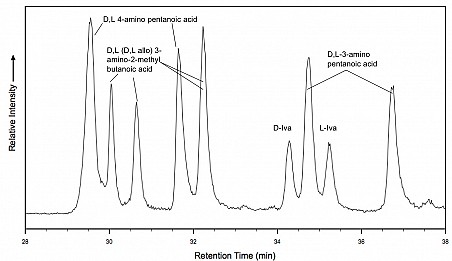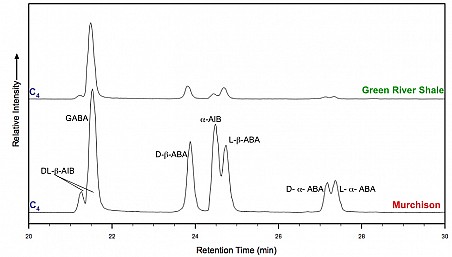2008 Annual Science Report
 NASA Goddard Space Flight Center
Reporting | JUL 2007 – JUN 2008
NASA Goddard Space Flight Center
Reporting | JUL 2007 – JUN 2008
Research Activities in the Astrobiology Analytical Laboratory
Project Summary
A little over 4.5 billion years ago, our solar system was a disk of gas and dust, newly collapsed from a molecular cloud, surrounding a young and growing protostar. Today most of the gas and dust is in the spectacularly diverse planets and satellites of our solar system, and in the Sun. How did the present state of the planetary system come to be from such undistinguished beginnings? The telling of that story is an exercise in forensic science. The “crime” occurred a long time ago and the “evidence” has been tampered with, as most planets and satellites display a rich variety of geological evolution over solar system history.
Fortunately, not all material has been heavily processed. Comets and asteroids represent largely unprocessed material remnant from the early solar system and they a represented on Earth by meteorites and interplanetary dust particles (IDPs). Furthermore, telescopic studies of the birth places of other solar systems allow researchers to simulate those environments in the laboratory so that we may characterize the organic material produced.
We are a laboratory dedicated to the study of organic compounds derived from Stardust and future sample return missions, meteorites, lab simulations of Mars, interstellar, proto-planetary, and cometary ices and grains, and instrument development. Like forensic crime shows, the Astrobiology Analytical Laboratory employs commercial analytical instruments. However, ours are configured and optimized for small organics of astrobiological interest instead of blood, clothing, etc.
Project Progress
A little over 4.5 billion years ago, our solar system was a disk of gas and dust, newly collapsed from a molecular cloud, surrounding a young and growing protostar. Today most of the gas and dust is in the spectacularly diverse planets and satellites of our solar system, and in the Sun. How did the present state of the planetary system come to be from such undistinguished beginnings? The telling of that story is an exercise in forensic science. The “crime” occurred a long time ago and the “evidence” has been tampered with, as most planets and satellites display a rich variety of geological evolution over solar system history.
Fortunately, not all material has been heavily processed. Comets and asteroids represent largely unprocessed material remnant from the early solar system and they a represented on Earth by meteorites and interplanetary dust particles. Furthermore, telescopic studies of the birthplaces of other solar systems allow researchers to simulate those environments in the laboratory so that we may characterize the organic material produced.
We are a laboratory dedicated to the study of organic compounds derived from Stardust and future sample return missions, meteorites, lab simulations of Mars, interstellar, proto-planetary, and cometary ices and grains, and instrument development. Like forensic crime shows, the Astrobiology Analytical Laboratory employs commercial analytical instruments. However, ours are configured and optimized for small organics of astrobiological interest instead of blood, clothing, etc. This role allows us to work with other themes within GCA and other NAI teams. To further the study of authentic samples, extraterrestrial samples, and their analogs, this year we have achieved the following:
- The completion of a more detailed analysis of the Stardust Amines from last year’s preliminary examination of bulk aerogels and foils which were exposed to the comet.
- Analysis of the 13C/12C ratio of the glycine extracted from these samples has proved to be much more complex than anticipated. Problems have derived from inorganic impurities in the samples (e.g. borate) that prevented a determination of glycine. However, the terrestrial nature of the ε-amino-n-caproic acid was confirmed with this analysis. We have since perfected our technique and have been approved to receive additional Stardust material to analyze in early 2009.
- Also using compound specific isotopic analysis, we were able to measure the 13C enrichment in various amino acids extracted from CR2 meteorites. We have additionally characterized the amino acids in these via LCMS (see Figure 1). As with Stardust, understanding the origin of these compounds allows for a better grasp on the nature of material delivered to the early Earth and other nascent planets.
- In collaboration with CIW, we have been studying the isotopic fractionation during laboratory-simulated hydrothermal carbon-carbon bond formation.
- In collaboration with CIW and UW teams, we reported the 13C enrichment in two nucleobases in the Murchison meteorite.
- We have been studying the exchange of amino acids among Antarctic meteorites, micrometeorites, ice, and collection materials to better understand how prebiotic compounds leach out of extraterrestrial materials and to evaluate the amine contamination of the ANSMET, NASA JSC meteorite, and Apollo collections.
- We made great progress in understanding the apparent L-isovaline enrichment in laboratory-irradiated butylamine containing ices. This has implications for the formation of C-5 amino acids in carbonaceous meteorites (see Figure 2). We are in the process of analyzing six carbonaceous meteorites for enantiomeric enrichments in their C-5 amino acids.
- We made tremendous progress in our attempts to analyze the amino acids in an individual IDP or Stardust grain. At the current (much improved) rate of progress, we anticipate only one more year of development will be necessary.
- We have collaborated with ARC to detect uracil produced from the photolysis of pyrimidine-containing ices
- We collaborated via ASAP (our NAI DDF project, P. I. Glavin) to evaluate the bulk isotopic ratios and amino acid content in a variety of Mars analogs and other natural materials using ground-truth future Mars instruments (e.g. on MSL & ExoMars) (Fig. 3).
- We performed more testing of the silyating agent to be used on MSL (GCA Theme IV).
- With CIW we studied the amino acids in extracts from some of Stanley Miller’s original spark discharge experiments.
- We hosted three undergraduate students (James Doty, Joshua Stern, and Ariel Lewis). Mr. Doty presented his results as a poster at the 2008 LPSC meeting. We anticipate that Ms. Lewis (SUIA Intern, 2008) will present her results at the 2009 LPSC meeting.
- We recruited a new NPP Fellow, Dr. Michael Callahan, from the laboratory of Prof. M. de Vries (UCSB). He will study nucleobases and other nitrogen-heterocycles in extraterrestrial samples and simulations.
Dworkin has also been deeply involved in preparing the Phase-A Proposal for the OSIRIS Discovery-12 mission. This carbonaceous asteroid sample return mission addresses three points of the Astrobiology Roadmap:
(2) Determine any chemical precursors of life in the solar system.
(3) Characterize the cosmic sources of matter for potentially habitable environments in the solar system.
(6) Understand the principles that will shape the future of life, both on Earth and beyond.
Since this mission was not selected late in 2007, he has been working with the team to re-propose a similar mission later this year.



-
PROJECT INVESTIGATORS:
-
PROJECT MEMBERS:
Jamie Cook
Research Staff
Daniel Glavin
Research Staff
Jennifer Stern
Research Staff
-
RELATED OBJECTIVES:
Objective 1.1
Models of formation and evolution of habitable planets
Objective 2.1
Mars exploration
Objective 2.2
Outer Solar System exploration
Objective 3.1
Sources of prebiotic materials and catalysts
Objective 7.1
Biosignatures to be sought in Solar System materials
